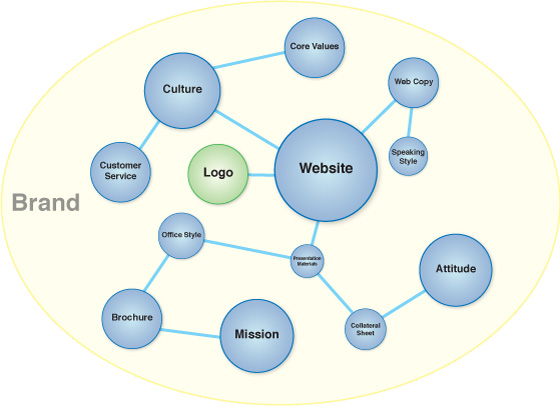Brand positioning can be a confusing process. In general, the term “branding” is used as a generic way to describe a business, their logo, and their visual style. Many people tend to use “brand” interchangeably with “logo” and vice-versa because they associate the idea of a brand with a symbol or visual representation. While it’s true that a huge portion of a brand is represented visually, there’s much more to it than just images, graphics, and colors. We thought we’d take a moment to help clear up the confusion and explain the difference between branding and a logo. And since it’s such an integral part of both, we’ll also clarify the role of brand positioning.
Defining Brand Positioning & Why a Logo is NOT a Brand
A brand is the experience that surrounds and defines a business.
It’s the essence of your business, a perception of value that’s promised to your customers, leads, and prospects. When you get down to it, a brand is made up of a collection of tools that create your company’s personality and allow you to strengthen brand positioning.
What is a logo if it’s not the brand?
A logo represents the visual personality of your brand.
It helps people identify your brand in a single glance and associate it with the name of your business. It sets the tone for how people will interact with your brand.
And finally, we’ve arrived at brand positioning:
Brand positioning is the space you want your company to occupy in the minds of your customers and prospects.
A unique and compelling brand has the ability to establish stellar brand positioning in their marketplace.
Common Brand Tools

Brand positioning is accomplished by combining brand tools that build equity for your businesses. Together, these tools will define the essence of your brand.
Common Brand Tools:
- The logo mark
- Color palette
- Mission statement
- Products and services
- Quality
- Value
- Copywriting
- Customer service
- Photography
The list goes on and on. It all boils down to this: Everything you do to convey how great your company is to your customers is part of brand positioning. Each brand tool is a puzzle piece that can be used to create your brand story.
 Let’s use Apple as an example; Their brand is fairly easy to figure out. When you think of Apple, do you only think of their logo? Of course not. It might be the first thing you think of, but you would most likely also associate them with innovation, great design, the iPhone, user-friendly interfaces, and so on. Their logo is just part of their brand positioning and a small piece of the bigger brand puzzle. As a brand, Apple is all about the experience of who they are, what they stand for, and how their products improve the lives of their customers.
Let’s use Apple as an example; Their brand is fairly easy to figure out. When you think of Apple, do you only think of their logo? Of course not. It might be the first thing you think of, but you would most likely also associate them with innovation, great design, the iPhone, user-friendly interfaces, and so on. Their logo is just part of their brand positioning and a small piece of the bigger brand puzzle. As a brand, Apple is all about the experience of who they are, what they stand for, and how their products improve the lives of their customers.
 How about Coca-Cola? Everyone knows the iconic Coca-Cola logo. While it may just be a visual element, it also carries valuable brand equity that’s been promoted for almost a century. It instills a sense of nostalgia and happiness in their audience. It’s no mistakes that all those feelings are closely tied to their brand values, such as refreshing, Americana, fun, freedom, enjoyment, family, and friends.
How about Coca-Cola? Everyone knows the iconic Coca-Cola logo. While it may just be a visual element, it also carries valuable brand equity that’s been promoted for almost a century. It instills a sense of nostalgia and happiness in their audience. It’s no mistakes that all those feelings are closely tied to their brand values, such as refreshing, Americana, fun, freedom, enjoyment, family, and friends.
How Important is Your Logo?
While the logo by itself does not make a brand, it is still a crucial part of your brand’s identity. It helps to shape the opinions of prospects early on in the sales and purchasing process. When someone sees your logo it needs to accomplish several things all at once:
- Provide insight into what your company’s purpose
- Establish brand positioning by conveying quality and value
- Establish credibility
- Instill confidence in your brand
A professionally designed logo in combination with a great business can pave the way for exceptional brand positioning that strikes a chord with prospects, leads, and customers. If you didn’t have time to read this whole post and you’ve skimmed like a superstar, here’s the key takeaway:
Your brand is the personality and essence of your business.
Your logo is your 24-7 sales representative.
Brand positioning is how the customer perceives your brand.
-FINAL(01-00)-White&Blue-01.svg)





